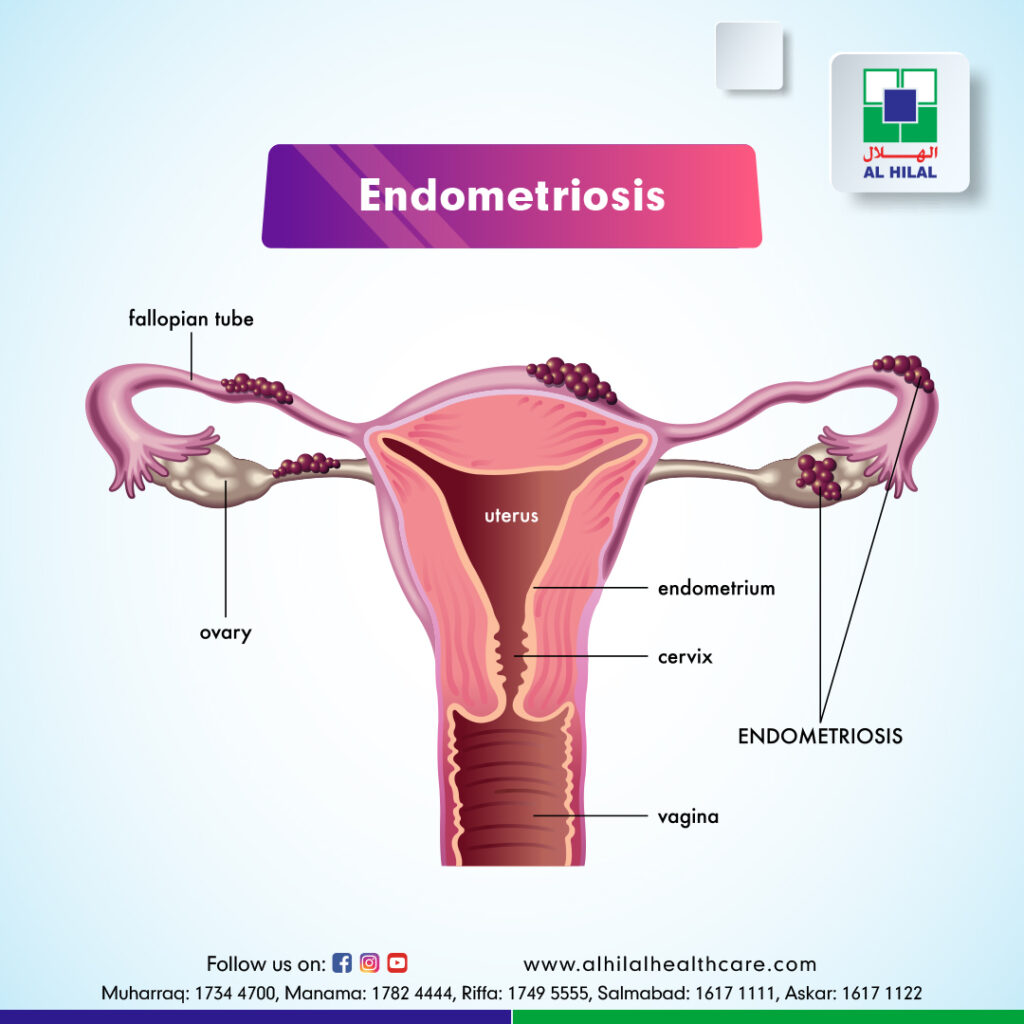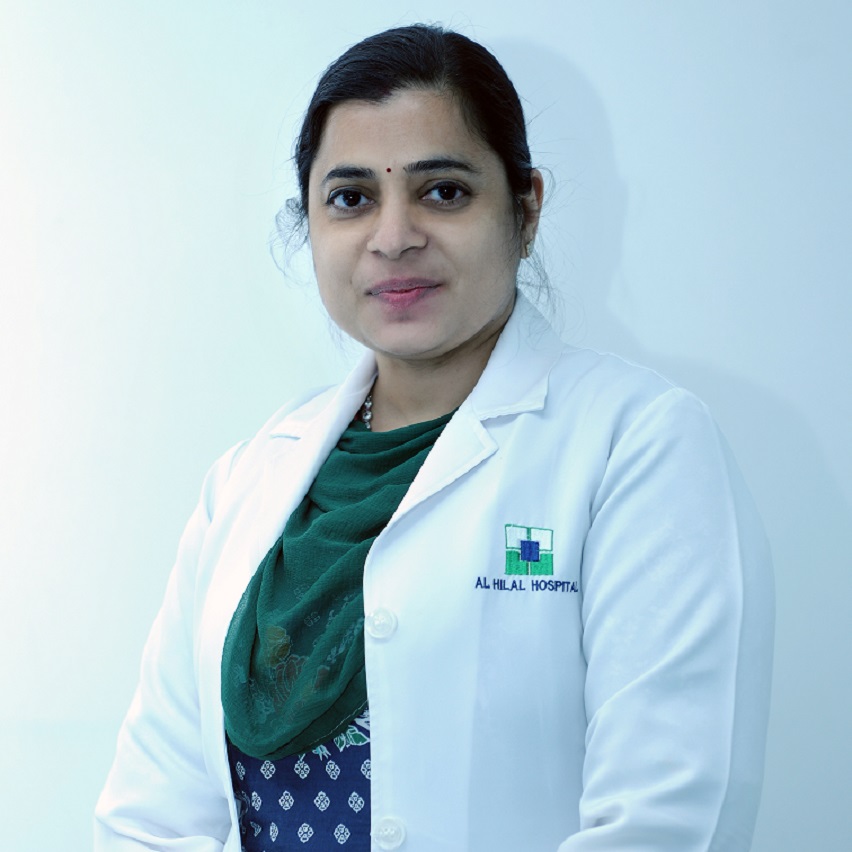What is endometriosis?
The endometrium is the tissue that lines the uterus. Endometriosis is a condition in which endometrial-type tissue is found outside the uterus. Ovaries and fallopian tubes are the most commonly affected. This misplaced tissue undergoes cyclical changes similar to the uterine lining, which includes thickening, breakdown, and bleeding under hormonal influence. There is no natural exit for this tissue and blood as these tissues are trapped without a natural opening, unlike inside the uterus.

This can result in fluid-filled cysts covered with endometrial-type tissue. Surrounding tissue can become irritated, eventually developing scars and adhesions. This itself and adhesion bands can damage the structure and thus the function of the affected and nearby organs like the intestine, bladder, appendix, fallopian tube, and ovaries. This can result in chronic pain and symptoms related to the affected organs. The blood-filled cysts (fluid-filled spherical tissues with a cover are known as cysts) with endometrial lining as cover are known as endometriomas or endometriosis cysts or chocolate cysts which can mimic ovarian malignancy sonologically and can cause a diagnostic dilemma. The damage to the ovary and fallopian tube can result in infertility. Endometriosis affects 2-10% of women between 25 and 40.
TYPES OF ENDOMETRIOSIS:
- Superficial Peritoneal Endometriosis
The peritoneum is a thin membrane that lines the abdomen and pelvis. It also covers most organs inside the abdominal cavity. This is the least severe form as the lesions are superficial.
- Endometriomas
This has been described already. This can vary in size and appear in different parts, but they are most common in the ovaries. This can get infected or ruptured. Infection can result in pain and fever. Rupture is associated with sudden severe pain, fainting, and dizziness and can result in blood loss.
- Deeply Infiltrating Endometriosis( DIE)
This happens in only 1%to 5%of people with endometriosis.
- Abdominal wall endometriosis
For example, at C Section or laparoscopy, scar.
STAGES OF ENDOMETRIOSIS:
- Stage 1 or minimal: There are only a few implants, and there is little to no scar tissue.
- Stage 2 or mild: More implants, deeper involvement, and scars.
- Stage 3 or moderate: There are many deep implants. You may also have small cysts on one or both ovaries and thick bands of scar tissue called adhesions.
- Stage4 or severe: Many deep implants and thick adhesions. There are also large cysts on one or both ovaries.
CAUSES OF ENDOMETRIOSIS:
The exact cause is still not sure, but a few explanations are available as described below:
- Retrograde menstruation is the backflow of uterine lining cells (the endometrial cells) through the fallopian tubes and entry into the pelvic cavity.
- Transformation theory-some hormones or immune factors promote the transformation of peritoneal cells (the cells that line the inner surface of the abdomen) into endometrial-like cells.
- Embryonic cell transformation – Hormones like estrogen transform embryonic cells (cells in the earliest part of development) into endometrial-like implants during puberty.
- Surgical scar implantation – the implantation of endometrial cells to abnormal sites following cesarean section or hysterectomy (the surgery in which the uterus is removed).
- Endometrial cell transport – through blood vessels or tissue fluids (lymph).
- Immune system disorder – the body fails to recognize and destroy endometrial-like tissue growing outside the uterus.
- Genetics – the condition tends to run in families and affects people of certain ethnic groups more than others.
SYMPTOMS OF ENDOMETRIOSIS:
- Pelvic pain of any severity before, during, or following menstruation can sometimes be associated with bowel movement or sexual intercourse. However, the primary symptom is pelvic pain.
- Painful urination, urgency, blood in the urine
- Low backache
- Diarrhea, constipation, blood in stool, bloating
- Infertility
- Leg pain
- Shoulder pain, upper abdominal pain, chest pain during inhalation, blood in the sputum, dyspnoea, etc., with endometriosis affecting the diaphragm (the separation between chest and abdomen)
- Heavy periods
Most of the time, the type and stage do not correlate with symptomatology. So, for example, the pain associated with stage 1 can be worse than that with stage 4. But infertility is more familiar with stages 3 or 4.
DIAGNOSIS OF ENDOMETRIOSIS:
It can be challenging to diagnose endometriosis because the symptoms can vary considerably, and many other conditions can cause similar symptoms. Cyclical symptoms such as pelvic pain can point towards endometriosis though symptoms can also be non-cyclical. In symptomatic patients, endometriosis may be suspected following a pelvic examination from the restriction of uterine mobility and feeling of nodules or soft mass or cyst around the uterus. But a minute or small endometriosis tissues may not be clinically palpable. Ultrasound examination can reveal some endometriosis if they are not minute. Rarely is MRI may be indicated in cases of a complex cyst with adhesions to delineate the anatomy. Laparoscopic (keyhole) examination of the abdomen and pelvis in cases of undiagnosed abdominal or pelvic symptoms or as a part of the step-wise evaluation of infertility is the final resort. The endometriosis tissue appears brownish- blackish with adhesions, cysts, or powder-like. And the definitive diagnosis of endometriosis can be made only after microscopic examination of a tissue specimen obtained through laparoscopy or surgical resection.
WHO NEEDS TREATMENT FOR ENDOMETRIOSIS?
All patients with more than mild symptoms need treatment for endometriosis at least to relieve their symptoms. However, mildly symptomatic patients without any infertility may not take medicine.
TREATMENT FOR ENDOMETRIOSIS:
Doctors typically try conservative treatment first, opting for surgery if initial treatment fails. In cases of infertility or with failure of medical therapy to alleviate symptoms or persistent cysts, surgery to remove endometriosis lesions and lysis of adhesion bands may be needed. The surgery can be conducted laparoscopically (keyhole) most of the time. Rarely for persistent severe pain in parous women or complicated adherent cysts, hysterectomy( removal of the uterus) may be required. If ovaries are retained, endometriosis can recur. If ovaries are removed, hormone replacement therapy may be needed in the future.
Medical therapy includes pain killers like paracetamol, NSAIDs (non-steroidal anti-inflammatory drugs, such as ibuprofen and naproxen), and hormones. Hormone therapy includes combined oral contraceptive pills, contraceptive patches, vaginal rings, intrauterine progesterone system (Mirena, Skyla), injection (Depo-Provera), and the implant (Nexplanon), pill (Camila) and GnRH agonists (gonadotropin-releasing hormone analogs). Hormone therapy helps decrease the cyclical hormone-sensitive changes in the endometrial tissue and thereby temporarily alleviates the symptoms. Unfortunately, GnRH agonists can be used only temporarily due to menopause-like signs and osteoporosis (softening of the bone). In addition, hormone therapy is associated with contraception or reduced fertility, and so not suitable if infertility is the main complaint.
RESULTS OF TREATMENT FOR ENDOMETRIOSIS:
Currently, there is no cure for endometriosis.
Symptoms like pain can improve with pain killers and hormone treatment.
Surgery will only remove the endometriosis at the time of surgery but not stop the growth of other implants. Therefore, suppressing the women’s period typically with birth control pills is the only effective treatment to stop the growth and prevent further damage.
Surgery to remove endometriosis can improve or relieve pain and help to improve the chances of getting pregnant As a result, infertility may need more advanced treatments like IVF (in vitro fertilization) or beyond. As a result, infertility may need more advanced treatments like IVF (in vitro fertilization) or beyond. The surgery can result in other problems related to anesthesia, infections, bleeding, and damage to the affected and nearby organs.
ENDOMETRIOSIS TREATMENT IN BAHRAIN:
Al Hilal Hospital is the largest and fastest-growing chain of private healthcare providers in Bahrain, with five branches. Al Hilal Healthcare Group is committed to providing high-quality healthcare services at an affordable price to the people of Bahrain through a combination of superior medical technology and excellent clinical services. Its vision is to be the largest healthcare service provider in the region by catering to the needy at the most affordable rates.
The Department of Obstetrics and Gynecology has been providing comprehensive healthcare for women. As a result, the healthcare group has successfully treated many patients with various Gynaecology issues.
ENDOMETRIOSIS SPECIALIST IN BAHRAIN:
Al Hilal Healthcare group is equipped with several well-qualified and experienced Gynecologists who are specialists in treating various Gynaecology problems. Even though there are no treatments for Endometriosis, the doctors have eased the symptoms so that the condition does not interfere with the patient’s daily life.


